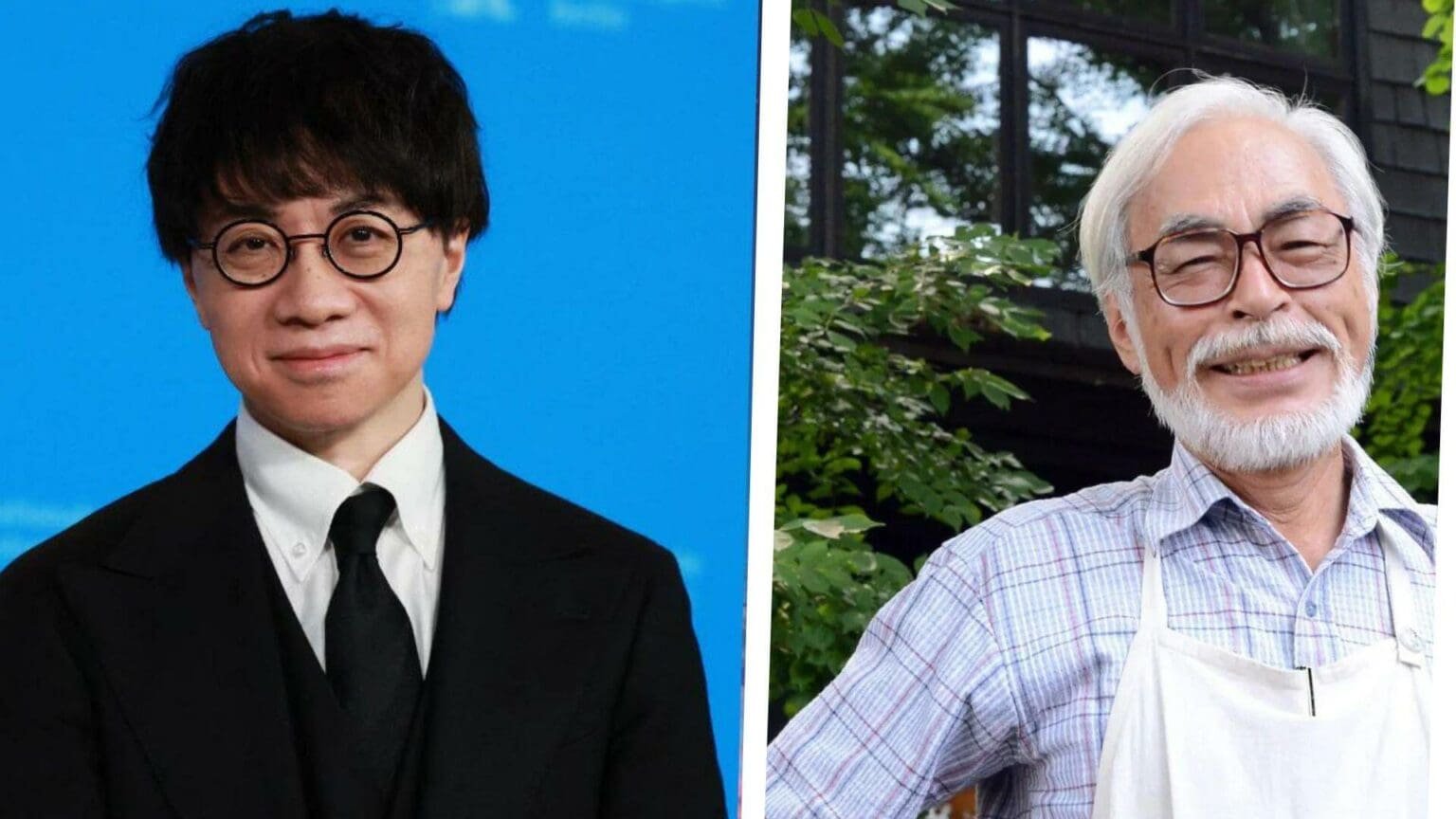Studio Ghibli and Makoto Shinkai are the two stalwarts of the anime film world. With their names recognized globally, Shinkai and Ghibli’s producer Hayao Miyazaki have proceeded to test the limits of what anime at the box office can and will do. Despite having created certain films beyond his time with Ghibli, Miyazaki has remained the indomitable ruler of the medium, with stories of his like Spirited Away even receiving an Oscar – something unheard of in the anime community. With stories closely entwined with environmental themes and mourning the loss of a green world, Miyazaki’s films have stood the test of time.
Meanwhile, Shinkai’s filmography has gone on to be unchallenged even in contemporary times – except for one. The newest name being uttered by hardcore anime viewers and casual fans alike is that of Makoto Shinkai, whose breathtaking visuals have captured the pains and pleasures of a younger generation. He has often been called the new Ghibli, or the new Miyazaki, with some even claiming that he has surpassed the latter.
With the recent release of Suzume by Shinkai and the upcoming culmination of Miyazaki’s hard work in How Do You Live?, the rivalry is even more prominent in the minds of fans. However, whether you choose to believe who is holistically better or not, there are certain things Ghibli does better than Shinkai, and vice-versa. Shinkai’s films delve into the idea of ecology and the environment and features talking creatures as well, but he chooses to highlight different things through his storytelling technique.
Character driven stories and 4 other things Makoto Shinkai does better than Studio Ghibli
Character driven
To say that Shinkai’s stories are character-driven are character-driven is akin to saying that the sun rises in the East. Well, that is not entirely true as the sun seems to rise because the Earth revolves… but anyway! You are not here for an astronomy lesson. If you have watched Suzume or Weathering with You, you know how motivated the characters can be, choosing to prioritize their loved ones over the fate of their world.
Suzume’s desire to save Souta triumphs over her sense of duty towards the city of Tokyo, while the ending of Weathering with You shows a sinking Tokyo that could have been avoided had the protagonists chosen to forsake their love. While such motivations of protagonists might be regarded as selfish and morally wrong by conventional ethics, they have their own charm. In fact, Shinkai manages to portray it so that we can empathize with his characters and applaud them for taking the brave – even if unconventional – method out of a conflict. After all, who wouldn’t want a friend who would choose you over the world?
Animation style
This is hardly a surprise, considering how Shinkai’s stories are more modern, and created with state-of-the-art technology. Ghibli’s filmography made the best of what its time had to offer but that does wane away now. Of course, it cannot all be credited towards the time of production. Shinkai’s texture of water and rain, and the dreamy ethereal quality envisioned in his films far surpass the forests, floating cities, neighbourhoods and post-apocalyptic wastelands of Ghibli’s story… at least, animation-wise.
In fact, it wouldn’t be a stress to say that a major part of what draws audiences to a Makoto Shinkai film is the visuals. Suzume has the best qualities of Shinkai’s film style, juxtaposing quirky indoor scenes and kawaii animals (Daijin and Sadajin) with gigantic monsters, the heart-wrenching portrayal of calamity and expansive landscape shots.
Romance
Shinkai’s romantic relationships between silly youths frequently rank among the most significant occasions in human history. A prominent example is Your Name. It follows the time-traveling romance of two teens from different parts of the world who wake up one day with different bodies, hailing from the bustling metropolis of Tokyo and rural Hida region respectively.
In Suzume, the story of Souta and Suzume has a similar effect, being closely entwined with the fate of the world and the country. While it might be thought that having romance be a major part of the story and being considered on an equal footing with calamity based on real events might be trivializing the same, it is in fact quite the opposite. It is only due to Shinkai’s brilliant storytelling that the films are a testament to the world-changing potential of young love.
Influence of environment and weather on human relationships
Weathering with You is regarded as an allegory for climate change – but in the end, it is a story of two young people in love. In fact, it might have been a better story for climate change had it been animated by Ghibli, at least as far as the grand narrative and our role in global warming is concerned. As usual, Shinkai does things differently and pulls it off with stupendous success.
In Suzume, Weathering with You and other stories, the conflict at the heart of the narrative is that between human beings. Yes, the weather is important and climate change needs to be taken care of – but Shinkai asks the question about how much all of that matters as an overwhelming influence an impact of human relationships. This is really evident in Garden of Words, and its unique portrayal of the weather’s personality.
Role of inanimate objects
The chair in Suzume was one of the funniest things to come out of the film, managing to deliver comedy without disregarding the high-stakes action and seriousness of the plot. If Studio Ghibli manages to showcase great instances of animal characters, Shinkai does the same with inanimate objects… and we are not just talking about objects that are even alive. The chair in the story was wrapped in layers of relevance, being a memorabilia from Suzume’s childhood and reappearing in her flashback.
In fact, the entire premise of Your Name revolves around the objects on which messages are left – where the actual smartphones, letters and digital or written messages are as important as the words themselves. The scene where Taki attempts to call Mitsuha but fails, or the scene where the comet is perceived by both characters and the audience members, highlight how inanimate objects can ironically bring life to the film and serve as focal points of the narrative.
Environmental themes and 4 other things Studio Ghibli does better than Makoto Shinkai
Environmental themes
What is the first thing that comes to mind after hearing Miyazaki or Studio Ghibli’s name? Is it the demonic animals of Princess Mononoke, driven to the dark side because of human actions on the environment? Is it the construction work of Pom Poko, and the futile attempts of the shapeshifting tanuki in protecting their forested home?
Or perhaps it is a glimpse into the future of a world torn by war… where human ingenuity has collapsed in on itself to create a world where giant insects and invasive plants are driving us to extinction? Either way, anyone who visits the theatre to get the Shinkai experience is undoubtedly going to remember the ecological nuances of the film even if the characters’ names are forgotten.
Plot driven
As such, it can be said that Ghibli’s films are driven by their plot which takes the form of a grand narrative that often morally warns us to take care of the environment. It does not need to be said, that if Studio Ghibli had been in charge of Weathering with you, there would have been a vastly different conclusion to the story.
We just cannot see Miyazaki choosing to have his protagonists choose their own mutual love over the safety of their world, can we? In fact, the separation between lovers in Princess Mononoke and several other films highlights how Ghibli films choose the plot and the overall altruism of public welfare over the individual happiness of the characters.
Strong female characters with ecofeminist tendencies
Strong characters in a plot-driven narrative are a rarity in media, but Hayao Miyazaki manages to pull it off. Remember San in Princess Mononoke, the wild girl taking on human civilization with her animal friends? What about the titular character of Nausicaa of the Valley of the Wind who travels the world and finds a way to be a brilliant fighter and a nuanced individual who can empathize with the scariest of the giant bugs?
Ecofeminism has varied definitions but generally regards the development of environmental or ecological themes with regard to female agency. As such, Miyazaki’s films and their strong environmentally-conscious women prove to have a much greater impact with regard to the same than the best of Shinkai’s female characters.
World building
This is a no-brainer, although to be fair, Hayao Miyazaki had a lot of time and experience to develop his world-building skills… and it was totally worth it. You must all remember the quaint rural environment of My Neighbour Totoro or the magically realistic locations of Spirited Away and how they manage to breathe life into seemingly inconspicuous locations.
Miyazaki does not stop there, and his filmmaking prowess is also evident in the dark forests of Princess Mononoke, the extraordinary castle of Laputa, the post-apocalyptic world of bugs and plants in Nausciaa: The Valley of the Wind and the homes of the shapeshifting tanuki in Pom Poko. While certain Ghibli films like The Place Promised in our Early Days has the potential to be ranked among the best of Miyazaki’s filmography, it is no doubt that the sheer scope of Ghibli’s fantastical worlds place it leagues ahead.
Role of animals
What better way to ride on the inherent biophilia (a psychological affinity towards animals and the natural world) than to have giant talking animals? The animals in Ghibli’s world are not Disneyfied creatures singing musicals or acting as wingmen for the protagonists, but intelligent and complex creatures with their own stories to tell.
The boar gods and the mysterious deer of Princess Mononoke, the modernizing racoon dogs in Pom Poko¸ the insects in Nausicaa: The Valley of the Wind, the spirits of Spirited Away and the fluffy mascot of My Neighbour Totoro are all nuanced entities in their own rights. They are not side characters only serving to be fodder in the protagonist’s journey but beings with their own stakes in the conflict, own ideas of morality and emotions.





